Plunge into the shadows of biblical caves, where secrets and sagas of faith unfold in the depths of the earth.
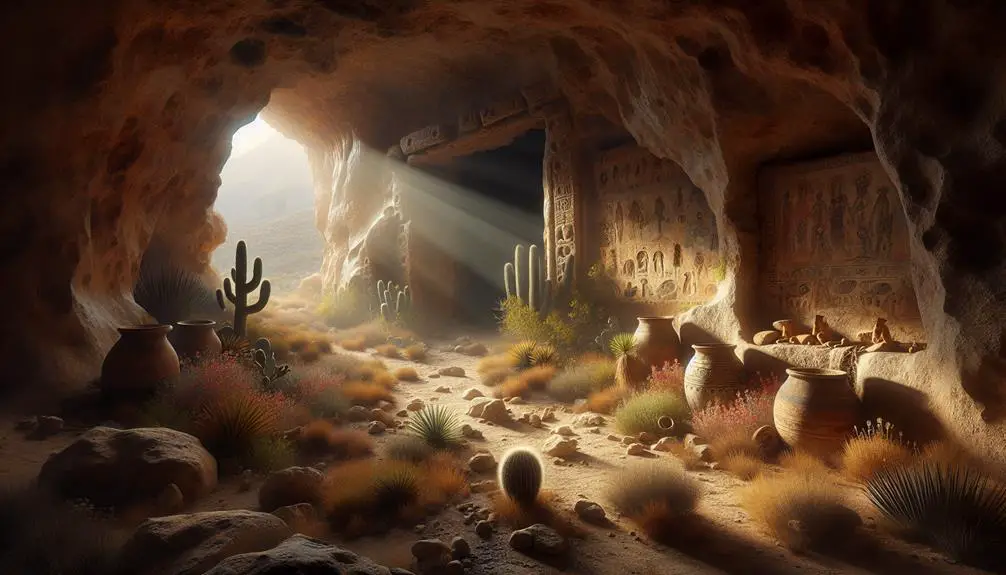
Caves in the Bible
In the tapestry of biblical narratives, caves aren't just geological formations; they serve as hidden chambers where faith, fear, and future destinies intertwine.
You'll find that these natural hideaways, from the Cave of Machpelah to the desolate retreats of Elijah, are more than mere backdrops. They're pivotal stages where human vulnerability meets divine intervention.
Whether it's a prophet seeking refuge, a king in hiding, or the final resting place of Lazarus, each cave holds a story that beckons you to explore further.
What secrets do these ancient shadows hold, and how do they shape the characters within them? Let's uncover the veiled mysteries and unspoken truths that lie within these biblical caverns.
Key Takeaways
- Biblical caves serve as sanctuaries for spiritual revelation and divine encounters, fostering deep introspection and communion with God.
- Caves hold historical and archaeological significance, offering insights into ancient religious practices, burial traditions, and collective resistance efforts.
- They symbolize protection and strategic refuge, providing shelter, sustenance, and defense against adversaries in times of need.
- The symbolism of caves in the Bible extends to themes of hiding, burial, rebirth, and the transformative power of prayer and repentance.
The Cave of Machpelah
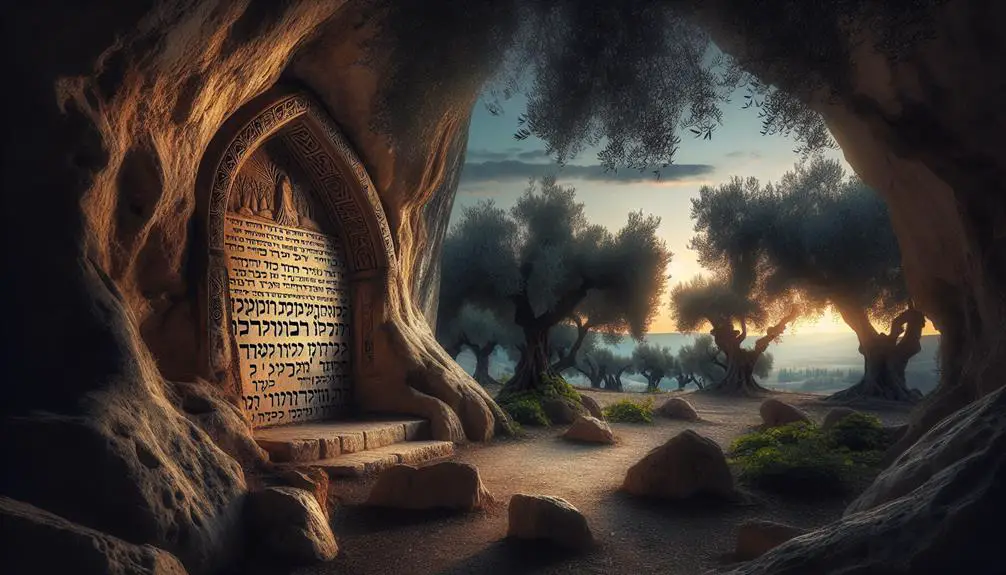
The Cave of Machpelah, historically significant within the biblical narrative, serves as the ancestral burial site for key patriarchal figures, including Abraham, demonstrating its profound religious and cultural importance. This cave, according to scripture, wasn't merely stumbled upon but was specifically chosen and acquired by Abraham, marking it as the first patriarchal burial ground. This deliberate selection and subsequent purchase by Abraham from Ephron the Hittite, as detailed in the Book of Genesis, underscores the cave's significance not only as a familial mausoleum but also as a tangible claim to the land promised by God to Abraham and his descendants.
The act of Abraham's purchase, meticulously recorded in biblical accounts, highlights the gravity of this transaction. It wasn't just a financial exchange but a foundational event, establishing a permanent, physical connection between the patriarchs and the land of Canaan. This act of acquisition underlines the importance of the Cave of Machpelah as a site of memory and identity for the Israelites, transcending its function as a mere burial site. It becomes a symbol of the covenant between God and Abraham's lineage, a physical manifestation of divine promise and human faith.
Furthermore, the repeated reference to patriarchal burials within this cave emphasizes its role in preserving familial and religious heritage. The interment of Isaac, Jacob, and their wives in the same cave reinforces the unity of the patriarchal family, binding them together in death as in life. This tradition of burial serves not only as an act of reverence but also as a reaffirmation of the covenantal relationship with God, underscoring the Cave of Machpelah's enduring legacy within the biblical narrative and Jewish history.
Elijah's Refuge at Horeb

You'll find that Elijah's refuge at Horeb isn't just a tale of escape but a narrative rich with divine encounter and spiritual significance.
This episode underscores Horeb's role as a place not merely of physical refuge but as a stage for profound spiritual revelation and transformation.
Analyzing this event, you uncover layers of meaning about faith, fear, and the nature of divine communication in biblical texts.
Elijah's Divine Encounter
In Elijah's divine encounter within the confines of Horeb's cave, scripture unfolds a pivotal moment of divine communication and profound spiritual reassessment. This episode, deeply entrenched in Elijah's depression and prophetic solitude, reveals the complexity of his psychological state and spiritual journey.
Seeking refuge in the cave, Elijah embodies the quintessence of isolation, an emblematic retreat from societal and personal turmoil. Yet, it's within this seclusion that he encounters God, not through grandiose manifestations, but in a gentle whisper. This subtle divine interaction underscores a critical theological motif: God's presence in quietude and subtlety, offering solace and guidance amidst despair.
Elijah's experience at Horeb thus serves as a profound narrative on the interplay between divine presence, prophetic mission, and personal tribulation, offering insights into the nuanced dynamics of spiritual encounters.
Horeb's Spiritual Significance
Exploring Elijah's refuge at Horeb unveils the mountain's profound spiritual significance, serving as a pivotal locus for divine-human interaction and contemplative retreat within biblical narratives. Often identified with Mount Sinai, Horeb's desert retreat setting underscores its role as a site of profound revelation and spiritual awakening.
It's here that Elijah, fleeing persecution, encounters God not in dramatic phenomena but in a 'still small voice,' emphasizing the intimate and personal nature of divine communication. This narrative layer enriches Horeb's significance, positioning it as a space where the divine transcends the spectacular, inviting deep, personal introspection.
The mountain thus emerges not only as a physical locale but as a symbol of spiritual refuge and revelation, pivotal in the journey of faith and understanding.
The Cave of Adullam
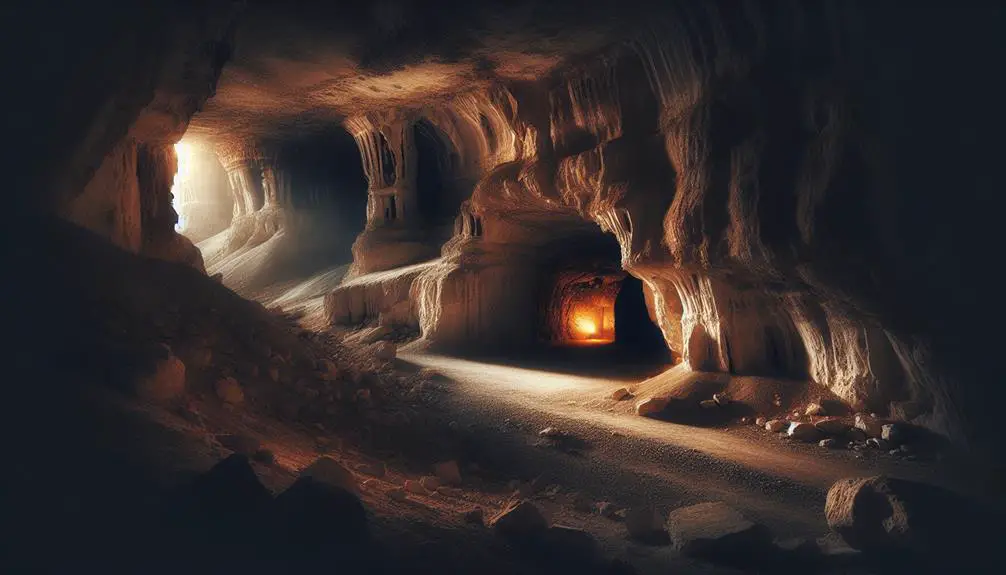
You must examine the Cave of Adullam not just as a geographical location, but as a pivotal site in biblical history, specifically in the life of David.
Its designation as David's refuge underscores its historical significance, providing insight into the socio-political dynamics of the time.
Analyzing its role illuminates the strategic, and perhaps symbolic, choices in David's resistance against Saul.
David's Refuge Location
The Cave of Adullam served as a crucial refuge for David, offering him sanctuary from King Saul's relentless pursuit. This location wasn't just a physical hideout but symbolized:
- Protection: Shielding David from Saul's pursuit, the cave's walls offered a tangible barrier against external threats.
- Isolation: Situated in a desolate region, it provided a place for introspection away from societal pressures.
- Communion: Here, David gathered loyal followers, transforming the cave from a mere refuge into a center of collective resistance.
In this narrative, the cave's symbolism extends beyond its physicality, embodying a sanctuary against oppression and a crucible for leadership. Analyzing this refuge reveals deeper layers of David's journey, marked by resilience against persecution and the forging of a profound communal bond amidst adversity.
Historical Significance
Beyond its symbolic resonance in David's narrative, Adullam's cave holds a profound historical significance that mirrors its biblical portrayal. Your exploration of this site isn't merely a journey through a physical location but an immersion into a narrative deeply embedded in the cultural and religious fabric of the time.
Cave metaphors, often employed in biblical texts, underscore themes of refuge, introspection, and transformation, all of which are vividly encapsulated in the account of Adullam. Archaeological discoveries within and around the cave further enrich our understanding, providing tangible links to the past.
These findings not only corroborate historical accounts but also offer insights into the daily lives, cultures, and spiritual practices of those who sought solace within its confines.
David's Hideout in En Gedi

Nestled among the rugged terrain of the Judean Desert, En Gedi served as a strategic hideout for David, fleeing from King Saul's relentless pursuit. This location wasn't chosen at random; its features provided significant advantages that ensured David's survival during a perilous period in his life. Analyzing En Gedi's role as David's hideout reveals a multifaceted sanctuary that was both practical and symbolic.
- Water Sources: Crucially, En Gedi is abundant in water, a rare and vital resource in the desert environment. The area's springs and waterfalls offered David and his followers a consistent supply for drinking and sustenance. This abundance also supported local agriculture and sustained desert wildlife, which could have provided food and camouflage.
- Desert Wildlife: The diverse fauna in the area, ranging from ibexes to leopards, played a dual role. Firstly, it provided potential food sources, crucial for David and his men's survival. Secondly, the presence of dangerous animals could have deterred Saul's forces from conducting a thorough search, offering an additional layer of protection.
- Strategic Location: En Gedi's caves and rugged landscape offered excellent defensive positions against potential attackers. The terrain allowed for effective surveillance of approaching forces, enabling David to evade capture. Moreover, the intricate network of caves provided hiding places that were difficult for Saul's army to navigate and penetrate.
En Gedi's significance as David's hideout extends beyond its immediate practical benefits. It symbolizes resilience and divine providence, serving as a testament to David's strategic acumen and his deep faith, which guided him through one of the most tumultuous times of his life.
The Burial of Lazarus
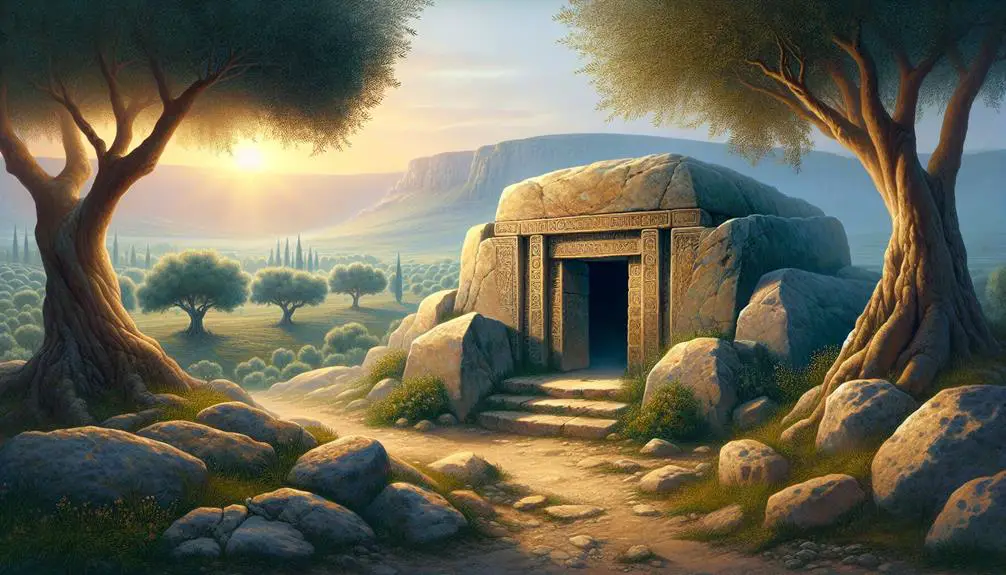
In recounting the burial of Lazarus, one finds a narrative deeply entrenched in the cultural and religious practices of ancient Judaism, which not only illustrates the customs of the time but also sheds light on the profound theological implications surrounding death and resurrection narratives within biblical texts. You'll see that Lazarus's tomb, a cave, becomes a central stage for a miraculous event, thus serving as a potent resurrection symbol in Christian theology.
Aspect |
Description |
|---|---|
Cave as Burial Site |
Ancient Judaic tradition often used caves as burial sites, embodying a natural return to the earth. |
Mourning Practices |
Mourning included specific rituals and lasted for a set period, reflecting respect and remembrance. |
Resurrection Symbol |
Lazarus's emergence from the cave signifies victory over death, a cornerstone of Christian faith. |
Cultural Relevance |
The narrative reflects and reinforces the intertwining of life, death, and spiritual rebirth. |
You're invited to delve deeper into the story of Lazarus, where mourning practices of the time, including the wearing of sackcloth and the application of ashes, underscore the communal aspect of grief. This story doesn't just recount a miracle but also offers a window into how death was navigated and understood in ancient times.
Moreover, Lazarus's resurrection prefigures a central tenet of Christian faith, encapsulating the hope and promise of life beyond death. Through this lens, the burial and subsequent raising of Lazarus in a cave illuminate the multifaceted symbolism of caves in biblical narratives – as places of hiding, burial, and miraculous rebirth.
The Caves of Qumran
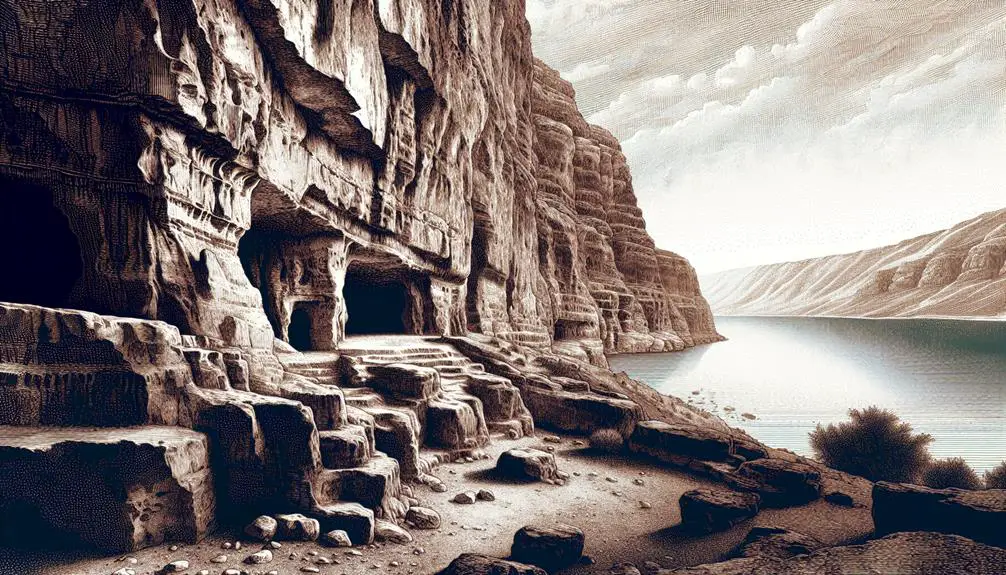
As you explore the historical and religious significance of caves in the Bible, the discovery of the Dead Sea Scrolls in the caves of Qumran offers a fascinating insight into Jewish culture and beliefs during the Second Temple period. This scroll discovery has been pivotal in understanding the diversity of Jewish thought and the development of early Christian texts.
The Qumran caves, situated near the Dead Sea, became the repository of a vast collection of Jewish manuscripts dated between the third century BCE and the first century CE. This discovery has significantly impacted biblical scholarship and our understanding of manuscript preservation. Here are three key aspects of the Qumran caves and the Dead Sea Scrolls:
- Historical Context: The scrolls provide critical insight into the religious practices, community life, and philosophical beliefs of the Jewish sect known as the Essenes. Their commitment to piety and celibacy, along with their apocalyptic expectations, are vividly reflected in the texts.
- Manuscript Preservation: The arid conditions of the Qumran caves played a crucial role in the preservation of these ancient texts. The combination of dry air and darkness helped prevent the deterioration of the parchment and papyrus scrolls, allowing them to survive for over two millennia.
- Scholarly Impact: The Dead Sea Scrolls have revolutionized our understanding of the Bible, offering variants and additions to the traditional Masoretic Text. They've enabled scholars to trace the evolution of biblical texts and have provided invaluable insight into the linguistic and cultural context of the time.
The caves of Qumran, thus, offer an unparalleled window into the past, shedding light on the complex tapestry of Jewish religious life and thought during a pivotal period in history.
Jonah's Prayer From the Fish

While exploring the profound significance of caves in biblical narratives, you'll find that Jonah's prayer from within the belly of a great fish stands as a pivotal moment, encapsulating themes of repentance, divine mercy, and human vulnerability. This narrative, often overshadowed by the spectacle of maritime miracles, delves deep into the spiritual transformation of the prophet, showcasing a profound moment of the prophet's repentance under extraordinary circumstances.
Jonah's prayer, articulated from the depths, mirrors the isolation and darkness of a cave, transforming the fish's belly into a sanctified space of introspection and communion with the divine. It's here, in the heart of despair and apparent doom, that Jonah's plea for salvation resonates with the universal human experience of seeking mercy amidst tribulation. The text meticulously describes Jonah's descent into the depths, both literal and metaphorical, reinforcing the motif of descent and ascent prevalent in spiritual journeys.
This episode not only highlights the omnipresence of God, even in the most remote and unimaginable locations but also underlines the transformative power of prayer and repentance. Jonah's deliverance from the fish, following his sincere repentance, serves as a testament to divine mercy, extending hope to all, irrespective of the depths one has fallen into.
Analyzing Jonah's prayer within this maritime context enriches our understanding of biblical narratives, emphasizing the intricate relationship between physical environments and spiritual epiphanies. It underscores the notion that places of confinement, whether a cave or the belly of a fish, can become catalysts for profound spiritual awakening and redemption, illuminating the path from despair to deliverance.
Frequently Asked Questions
How Have the Caves Mentioned in the Bible Influenced Modern Archaeological Methods and Studies?
You're exploring how ancient caves have shaped modern archaeological practices. Cave inscriptions have become vital clues, pushing archaeologists to refine analysis techniques and preserve historical narratives.
Meanwhile, the ethics of exploration have evolved, emphasizing respect and preservation over mere discovery. This shift ensures that the delicate balance between uncovering history and protecting it's maintained, reflecting a deeper understanding of our shared heritage and the methods needed to study it responsibly.
Are There Any Significant Religious Rituals or Traditions That Have Developed Over Time Specifically Related to the Caves Mentioned in the Bible?
Yes, you'll find that cave baptisms and pilgrimages to certain sites have become significant practices. These traditions often stem from a desire to connect more deeply with spiritual heritage.
For example, cave baptisms offer a unique, immersive experience believed to mirror ancient rituals, enhancing the spiritual significance. Similarly, visiting pilgrimage sites, especially those associated with caves, allows individuals to walk paths believed to be trodden by historical religious figures, enriching their faith journey.
How Do the Geological Features of These Biblical Caves Compare to Similarly Aged Caves Not Mentioned in the Bible?
You're diving into an intriguing comparison: how do the geological features of specific caves, when scrutinized through cave formations and speleothem analysis, stack up against their contemporaries not spotlighted in historical texts?
This inquiry necessitates a detailed, scholarly approach, dissecting the mineral compositions, formation processes, and environmental impacts influencing these subterranean wonders. Essentially, it's a quest to uncover if these scriptural caves hold unique geological characteristics or mirror the typical evolutionary patterns of similarly aged caves.
What Role Do These Caves Play in the Cultural and Historical Narratives of Non-Abrahamic Religions or Local Folklore?
You're exploring how caves have woven themselves into the fabric of non-Abrahamic religious stories and local folklore. These subterranean spaces often serve as pivotal stages for mythic tales, embodying both the sacred and the supernatural.
Local myths frequently cast these caves as homes to deities or spirits, integrating them deeply into the spiritual and cultural narratives. This folklore integration highlights their significance beyond geological features, enriching the communal identity and historical consciousness.
Can the Environmental Conditions Within These Caves Provide Insights Into the Climate and Ecological Changes in the Region Throughout History?
Absolutely, the environmental conditions within caves can offer you deep insights into historical climate and ecological shifts.
By examining cave microorganisms and conducting speleothem analysis, you're tapping into a rich, detailed record of past environments.
These methods provide a window into the variations in climate and ecology over millennia, helping you understand how these changes have shaped the region's natural history.
It's a fascinating, scholarly approach to uncovering our planet's past.
Conclusion
In examining the significance of caves within biblical narratives, it's clear they're not merely geographical features but pivotal in the unfolding of divine and human stories.
Among these, the Cave of Machpelah stands out, serving as the burial site for patriarchs and matriarchs, encapsulating over 4,000 years of religious reverence.
This statistic isn't just a number; it underscores the profound, enduring connection between physical spaces and spiritual legacies, highlighting how sacred geography shapes and reflects theological understanding in the biblical tradition.



Sign up